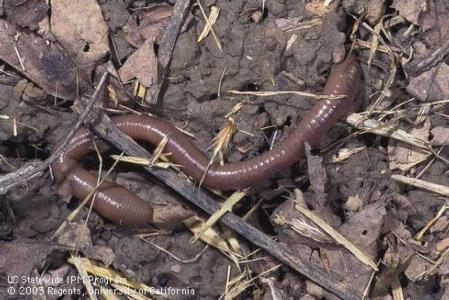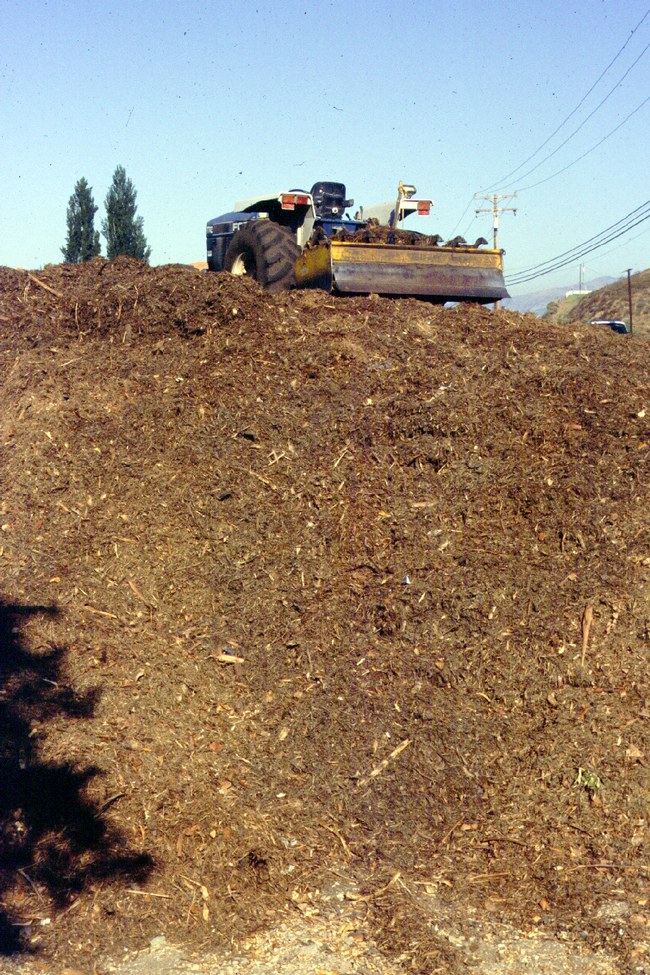
Posts Tagged: compost
Earthworm Problems?
Earthworms are commonly associated with “healthy” soils and in many cases they are good indicators. See a previous blog: //ucanr.edu/blogs/blogcore/postdetail.cfm?postnum=23945
In a recent blog, Michigan State University is telling a different story: http://msue.anr.msu.edu/news/the_dirt_about_earthworms
The popular view of earthworms – beneficial creatures that aerate the soil, feed robins and make good fishing bait – may be true in our gardens and tilled farm fields, but in forests it is a different matter.
Earthworms are not native to Michigan and the Great Lakes region, at least not since before glaciers covered the region; they were brought here during European settlement in the 1800s or possibly earlier. Plants, wildlife and forests evolved without any of these creatures around. They are now an invasive species that harms forests.
In gardens and agricultural fields, earthworms help improved soil structure and fertility, but in forests their effects are much different. Hardwood forests without earthworms have a thick layer of slowly decomposing leaves, or “duff” that promotes a rich community of wildflowers, tree seedlings and small animals. Earthworms change that environment dramatically by essentially consuming the duff, thereby destroying habitat and reducing fertility. In contrast to their effect in gardens, earthworms cause forest soils to become more compacted. As a result of habitat loss, fertility declines and soil compaction, these forests may be less productive and have poorer new tree regeneration in the long run.
If that wasn't bad enough, research shows that the combination of excessive browsing by deer (another serious threat to Michigan forests) and high earthworm populations in an area can have a worse effect than either one alone. Also, other invasive species, such as buckthorn, may have an easier time getting established in earthworm-infested areas. Without a diverse forest floor and new seedlings, the long term health of woodlands is threatened.
The connection between climate change and earthworms is complex. A warmer climate and longer growing season may hasten earthworm migration to previously worm-free forests. Introduction of earthworms make them more vulnerable to other climate-related stresses, such as more frequent and longer droughts. Although earthworms may reduce the amount of carbon entering the atmosphere through their soil action, on balance these creatures are a bad deal for northern forests.
Earthworm populations are not the same throughout Michigan forests – some areas have dense populations, others have few or none. They get from place to place very slowly. People, however, can transport them much more quickly on muddy tires, soil moved from place to place, and discarded fishing bait. There is no way to eliminate earthworms once they become established in woodlands.
In California, we have some native species of earthworms, but in many cases, non-native introduced species have come to dominate. The predominant native species belong to the Argilophilus and Diplocardia while many of the non-native are of European in origin in the Lumbricidae family. Many of these non-natives were probably introduced by settlers bringing plants from home, which had soil containing the worms. A survey of California earthworms by the US Forest Service can be found at:
https://www.fs.fed.us/psw/publications/documents/psw_gtr142/psw_gtr142.pdf
This is a wonderful description of earthworm biology and their occurrence in the California landscape.

earthworm
Dog Vomit Fungus
Avocado growers have been ecstatic at fruit prices and are walking their groves more avidly, checking things out and seeing lots of things they don't normally see. A recent grower find has been a blob of Fulgio septica - ‘Dog Vomit' or ‘Dog Fungus'. It's not vomit, it's not a fungus, but a slime mold that lives off the organic matter littering orchards and in mulched gardens. After the rains and when it starts to warm up, the spores of these non-animal, non-plants germinate and start moving around. They aggregate into a mass, called a plasmodium, a super individual that starts out as a yellowish, spongy mass that can move in a slow, amoeboid-like fashion. It gradually hardens and can take on the brownish-tan coloring seen in the image below. As it dries, it breaks up and blows away. It won't do harm to living plants, simply feeding on dead material. It will gradually disappear. So, as you walk your orchard or your backyard, enjoy the unusual appearance of a rainy year member of the web of nature.

dog vomit fungus
Soil Health Websites
A recent website just posted hopes to make research papers available to the general public. Many times these papers are locked away in archives or libraries and are hard to access. This website wants to change that. It is sponsored by various group0s, including USDA, University of Missouri, industry, Resource Conservative Districts and other entitites. It's a small data base at this point, but hopes to build over time. check it out:
http://soilhealthinstitute.org/about-us/
There's a lot of distracting stuff at the site, but the guts are at
http://www.soilhealthinstituteresearch.org/Home/Search
Other good ag websites are the USDA's National Ag Library:
USDA's Agricola
https://agricola-nal-usda-gov.ezproxy.lib.vt.edu/
USDA's ATTRA which is loaded with basic and detailed farming information:
USDA's Farming Information Center
https://www.nal.usda.gov/afsic
It's a new year, READ ON!!!!

soil
Cellulase Production by Different Mulch Sources
Biological control of Phytophthora cinnamomi in avocadothrough the use of mulches was identified by an Australian grower and later described as the "Ashburner Method" by Broadbent and Baker. The technique uses large amounts of organic matter as a mulch along with a source of calcium. Control of avocado root rot in the Ashburner method was attributed to the presence of Pseudomonas bacteria and Actinomycetes. Multiple antagonists are more likely the cause of biological control, since no single organism has been found to be consistently associated with soils suppressive to P. cinnamomi.
The use of organic mulches has multiple effects, such as altered soil nutrient and water status and improved physical structure. Any improvements in plant status resulting from improvements in the growing environment can improve plant health. The effect of organic amendments on soil physical and chemical properties can vary considerably depending on soil texture and the environment. One of the most consistent effects of organic amendments is an increase in biological activity. Increases in organic substrate lead to increased fungal and bacterial populations. In numerous cases, this increase in biomass has been associated with disease suppression. This biological control can be ascribed to several mechanisms: competition, antibiosis, parasitism, predation and induced resistance in the plant.
The microbial biomass is responsible for release of enzyme products and polysaccharides in soils. The microbially-produced enzymes cellulase and glucanase have been demonstrated to have a significant effect on Phytophthora populations. This mechanism of antibiosis is possible because the microbes are releasing these enzymes to solubilize organic matter. Unlike other fungi, Phytophthora have cell walls that are comprised of cellulose and in the process of decomposing organic matter with enzymes, an environment is created that is also hostile to the pathogen.
In order to see if there might be potential differences in organic materials being better at combating avocado root rot, a little field trial was established with 23 different types of materials (see types on Graphs 1 and 2). The mulch materials were obtained from nearby hedges and chipped or obtained from commercial sources of mulch. Some of these materials would be difficult to get in large amounts, such as manuka (Leptospermum scoparium), but others are commercially available chipped greenwaste. The materials were then spread on the ground to a depth of five inches, in separate plots that were 36 X 36 inch squares. Decomposition was measured over a two year period and then cellulase was measured in the mulch, at the soil / mulch interface and at a two inch depth in the soil at the end of 2 years.
Since cellulase production is part of the decomposition process, the rate of decomposition should be a partial indicator of the amount of cellulase present. Graph 1 shows the depths of various materials at the site after one and two years of decomposition. After a mulch application there is generally settling due to rainfall-caused compaction, but much of the decline by the second year is due exclusively to decomposition. The more recalcitrant materials, such as bark, wood chips and sawdust have barely lost half their depth after two years, while others such as shredded eucalyptus, manuka, avocado and willow are less than 20% of their initial depth. Much of the shredded/chipped material, such as eucalyptus had a significant fraction of leaves in the mulch. The wool disappeared a little after one year. The greenwaste + chicken manure compost is nearly the same depth as the wood chips, since it is a material that had gone through a decomposition process prior to its application and much of the easily digestible materials had already been decomposed.
The rate of decomposition has some bearing on the rate of cellulase production (Graph 2). Eucalyptus and manuka had the two greatest rates of decomposition and show the highest levels of cellulase production. The cellulase levels were consistent with all the different mulch materials. Using decomposition rate alone is not a complete indicator of cellulase production since, poplar, willow and avocado had high rates of decomposition, but their cellulase rates were half those of manuka and eucalyptus
It is clear that the cellulase effect is limited to the layer of mulch and not to depth within the soil. There is some effect at the soil surface, but at 5 cm. cellulase activity drops to background levels (Graph 2). There is earthworm activity at the test sites and one idea was that earthworm incorporation of organic matter would move the cellulase production into the soil. Maybe with further time this would occur. As it is, when mulches are applied to avocado, the roots tend to proliferate in the mulch, out of the soil where the cellulase activity is the least.
Something to keep in mind is that we do not know what levels of cellulase are necessary to control the root rot fungus. It may be that levels seen with pine bark are more than adequate. Also we have measured cellulase production at only one time in a two-year period and it is quite likely that this is not the best snapshot of what is happening before and after. A further reminder is that cellulase is only one of the many by-products associated with decomposition and many of the antagonistic properties that are associated with the microbial biomass are not being measured in this trial. Having developed this screening procedure what needs to be done next is to take high, medium and low cellulase producing mulches and challenge the fungus to verify that this is a good way to evaluate mulches.

mulch
Use of Mulch in Organic Orchards Called into Question
Because of potential contamination of mulches from pesticides, mulch use is being called into question and testing may be required for mulches applied to organic orchards. This is a recent ruling. As always, anything applied to a certified organic operation should be cleared with the certifier first.
http://www.prnewswire.com/news-releases/beyond-pesticides-federal-court-finds-usda-process-for-allowing-pesticide-contaminated-compost-improper-and-stops-use-300288112.html

agritourism2
